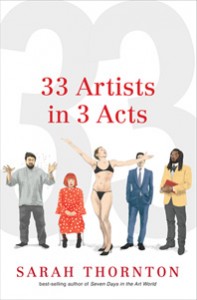[contextly_auto_sidebar id=”PVd8mrLaWjsXaMaGJ86HIjTmHjDjQjiA”]
WHAT has art — and the artist as its maker — come to mean after postmodernism and four decades after Warhol’s emergence? That’s a question Sarah Thornton — a very sharp British sociologist with an interest in visual art — asks in her newish book 33 Artists in 3 Acts.
I’m only partway through Thornton’s book, which is full of smart observations. A few lines from Anna Altman’s BookForum review keep echoing for me:
Contemporary artists, [Thornton] argues. are as devoted to their self-presentation as their artworks, managing their audiences with calculated, guarded gestures. Nothing is unselfconscious in this world. Everything is image.
Thornton tries to get Jeff Koons to talk in ways about something besides PR and platitudes, but can’t nail him down. “Koons’s discourse is so pat that you feel you are in the presence of an actor playing the role of an artist.”
It’s interesting to note that for some of the artists outside the Angl0-US axis, there is more at stake in art than money and image. (China’s Ai Weiwei is one of those chronicled.)
is one of those chronicled.)
This book may be even more insightful than her previous Seven Days in the Art World.

The ethos of the mid 60s was formulated by Timothy Leary as “Tune in, turn on, drop out.” (Interestingly, the phrase was given to him by Marshall McLuhan during a lunch they had together.) New forms of spirituality and concepts of social justice grew out of the movement, but much of its force had dissipated by 1980.
Leary later embraced the cyberdelic culture of the 90s when PCs began to become popular. Early video games (even if simplistic by today’s standards) and virtual reality became the new hallucinogens. Leary changed his slogan to “turn on, boot up, jack in.”
Amazon, Google, and Co. hadn’t yet evolved in Leary’s rather naive cyberdelic world. Merchandizing on the web was still defined as poor Netiquette. There was a determined but futile effort to keep the web uncommercialized.
We all know what has happened since then. The slogan became turn on, boot up, buy in. In a world of Internet surveillance, meta-data, and social engineering, the market itself became the new hallucinogen of the early 21st century. We thus see all these market-stoned strivers climbing the greasy pole. Good luck with your book. Timely.
As Thornton says in her first book, what art has become is an alternative religion. It is a type of existentialism that at one end of the spectrum, pretends to reach for transcendence, and at the other end of the spectrum (e.g. Koon) it says that transcendence is not in any way possible; so make it a brand and make some money..
If you go to my tumblr blog, “molecular artonomy” and scroll down about 15 entries or so, you can see a digital art work I did that is an artist’s response to some of the postmodern art that takes no craftsmanship and is all image management, specifically Damien Hirst’s piece, “The Impossibility of Death in the Mind of Someone Living.” I must admit some of his art is creative and I like the titles.